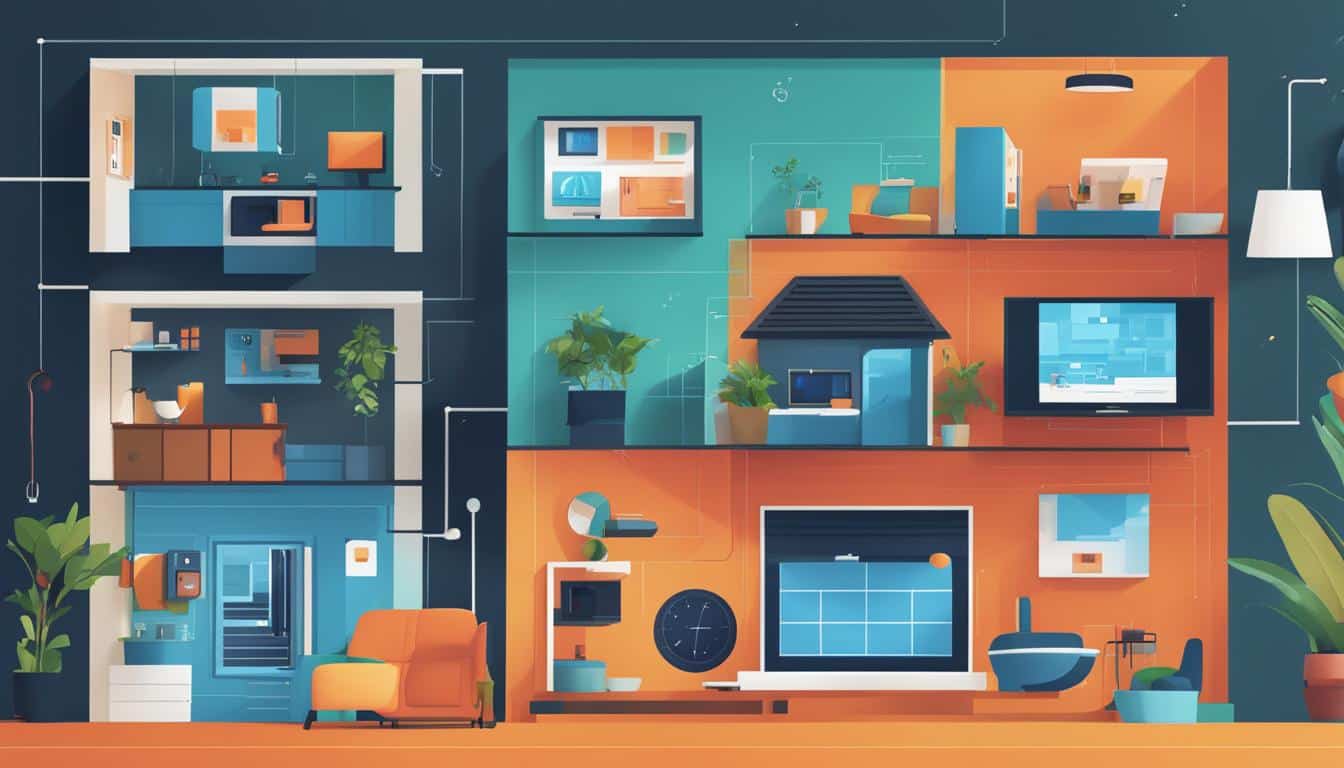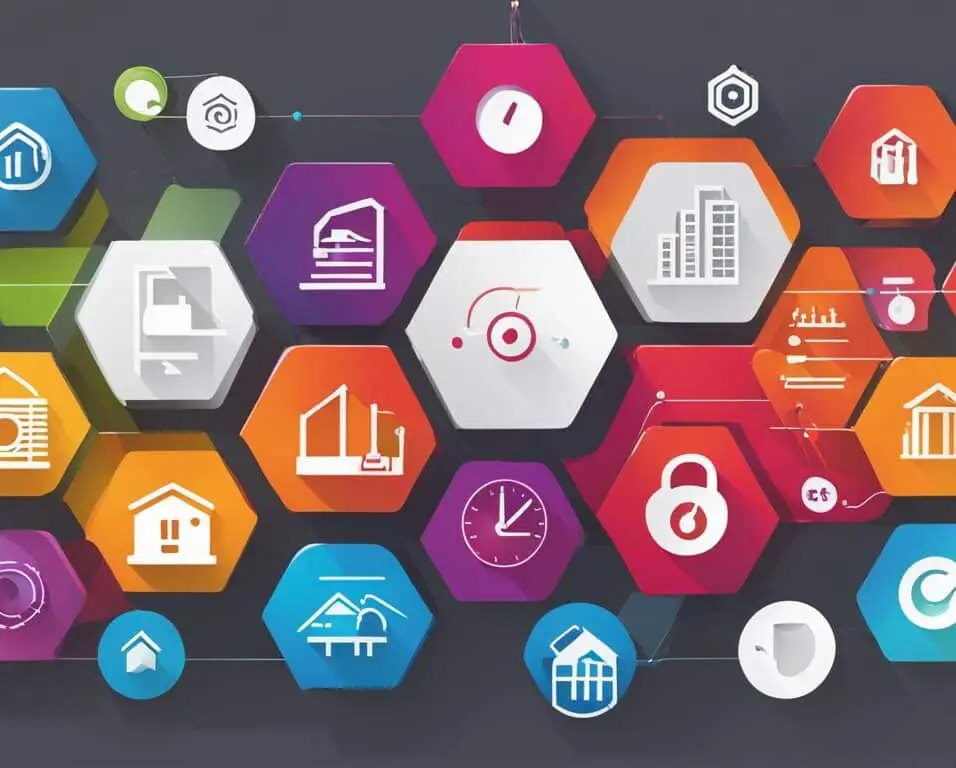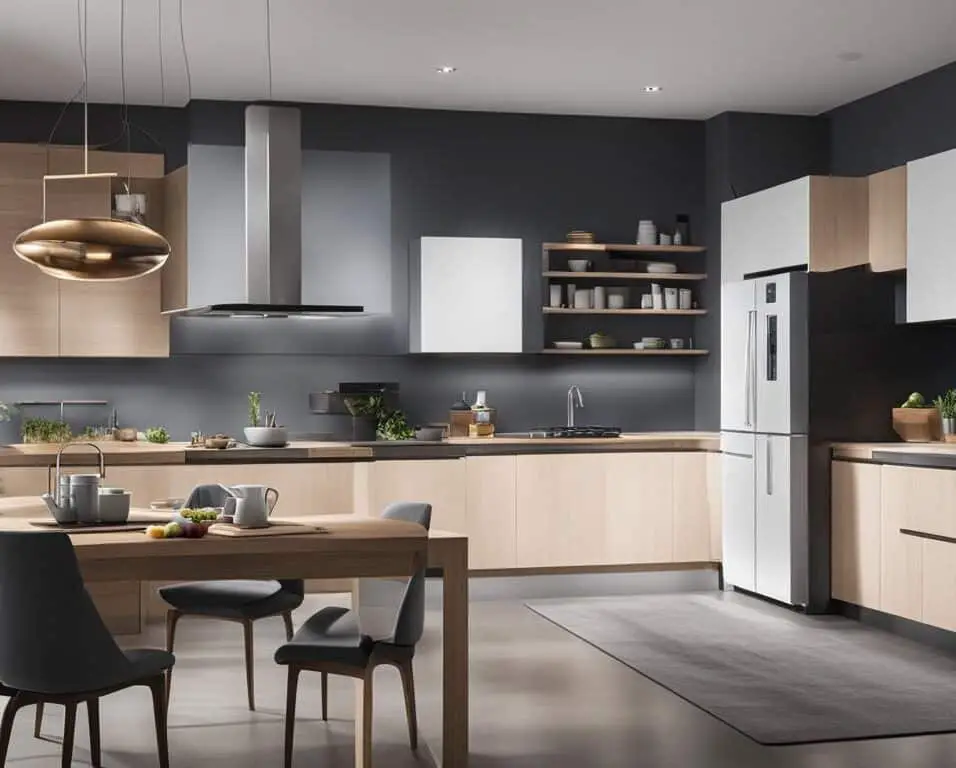The Smart Way to IoT: Home Automation Solutions
Welcome to my article about integrating IoT devices for efficient smart home solutions. In today’s digital age, homeowners have access to a vast array of technologies that can enhance their living spaces with personalized control and enhanced security. By leveraging big data analysis, artificial intelligence, edge computing, computer vision, voice recognition, and AR/VR technology, integrating IoT devices into your home can transform it into a smart home paradise.
Imagine being able to control your lights, temperature, appliances, and security systems with a simple voice command or through a mobile app. This level of convenience and control is made possible by integrating IoT devices into your home automation system.
But what exactly is IoT? IoT stands for the Internet of Things, a network of interconnected devices that communicate with each other and can be controlled remotely. These devices can range from smart thermostats and lighting systems to security cameras and smart locks.
Integrating IoT devices into your home brings countless benefits, including increased energy efficiency, improved security, enhanced comfort, and personalized automation. By optimizing your home’s efficiency, you can enjoy greater cost savings and a reduced environmental impact.
Key Takeaways:
- Integrating IoT devices can provide efficient and convenient solutions for smart home automation.
- Big data analysis, artificial intelligence, edge computing, computer vision, voice recognition, and AR/VR technology enhance the functionality and security of smart homes.
- IoT devices offer personalized control, energy efficiency, improved security, and enhanced comfort.
- With IoT, homeowners can control their home’s various devices and systems through voice commands or mobile apps.
- Integrating IoT devices into your home allows for cost savings and reduced environmental impact.
As technology continues to advance, integrating IoT devices into your home is the smart way to enhance your living space. Whether it’s controlling your home’s temperature while you’re on the go or receiving real-time security alerts, a smart home provides the ultimate convenience and peace of mind.
Stay tuned for the next section of this series, where we explore the role of big data analysis in IoT home automation.
The Role of Big Data Analysis in IoT Home Automation
Big data analysis plays a crucial role in enabling IoT home automation. By leveraging data processing frameworks and advanced analytics tools, homeowners can unlock valuable insights from the vast amount of data generated by interconnected home devices. This enables the automation of various tasks within the home environment, optimizing and personalizing the user experience.
Big data analysis allows for the collection, storage, and analysis of large volumes of data from IoT devices. This data, which includes information such as temperature, security alerts, energy consumption, and occupancy patterns, can be processed and analyzed to extract meaningful insights. Machine learning algorithms and artificial intelligence techniques can then be applied to uncover patterns, correlations, and trends within the data.
The Benefits of Big Data Analysis in IoT Home Automation
1. Optimized Energy Efficiency: The analysis of real-time energy consumption data can help homeowners identify inefficiencies and make informed decisions to reduce energy waste, leading to cost savings and a more sustainable lifestyle.
2. Enhanced Security: Big data analysis enables the identification of anomalous behavior and potential security threats by analyzing patterns and trends in device data. This helps homeowners detect and respond to security breaches more effectively, keeping their homes safe.
3. Personalized User Experience: By analyzing data from various sensors and devices, big data analysis enables personalized automation settings that align with the individual preferences and routines of homeowners. This creates a more comfortable and convenient living environment.
4. Proactive Maintenance: With big data analysis, IoT devices can provide predictive maintenance capabilities. By monitoring sensor data and identifying patterns that indicate potential issues, homeowners can address maintenance needs before they become major problems, leading to reduced downtime and increased device lifespan.
5. Data-driven Decision Making: The insights derived from big data analysis empower homeowners to make data-driven decisions regarding their smart home automation systems. By understanding usage patterns, energy consumption, and other relevant data, homeowners can optimize their smart home setup for maximum efficiency and cost-effectiveness.
Overall, by harnessing the power of big data analysis, IoT home automation becomes more intelligent, efficient, and personalized. Homeowners can enjoy the benefits of a smart home that meets their individual needs while minimizing energy consumption and maximizing security.
| Benefits of Big Data Analysis in IoT Home Automation |
|---|
| Optimized Energy Efficiency |
| Enhanced Security |
| Personalized User Experience |
| Proactive Maintenance |
| Data-driven Decision Making |
The Integration of Artificial Intelligence in Smart Homes
Artificial intelligence (AI) is revolutionizing the world of smart homes, transforming them into intelligent living spaces that cater to our every need. As the demand for IoT-powered homes increases, AI is becoming essential in delivering personalized and efficient automation solutions. AI acts as the “brain” of a smart home, utilizing advanced algorithms to learn from homeowners’ habits and behavior patterns, creating a seamless and intuitive user experience.
By recognizing patterns and analyzing data, AI enables smart devices to adapt and configure themselves according to user preferences. Imagine waking up to your preferred room temperature, with the blinds automatically adjusting to let in the perfect amount of sunlight. With AI, this level of personalization and convenience becomes a reality.
Moreover, AI enhances the security system in smart homes, providing an added layer of safety. By continuously monitoring and analyzing data from various sensors and cameras, AI can detect anomalies and send alerts in case of any potential threat. This proactive approach ensures a secure home environment, giving homeowners peace of mind.
The Benefits of AI in Smart Homes:
- Enhanced Automation: AI allows for intelligent automation of various tasks, such as controlling lighting, adjusting thermostats, and managing energy consumption. This automation not only saves time but also improves energy efficiency, resulting in cost savings.
- Improved Energy Management: With AI, smart home systems can analyze energy usage patterns and make adjustments to optimize energy consumption. This not only benefits the environment but also helps homeowners reduce their energy bills.
- Intelligent Assistance: AI-powered virtual assistants, such as Amazon’s Alexa or Google Assistant, enable voice-controlled interactions with smart home devices. This hands-free convenience enhances the user experience, allowing homeowners to control their homes effortlessly.
The integration of AI in smart homes is paving the way for a future where our living spaces seamlessly adapt to our needs and preferences. With AI as the core intelligence, we can enjoy personalized automation, enhanced security, and energy-efficient solutions that make our lives easier and more comfortable.

Enhancing IoT Home Automation with Edge & Fog Computing
Edge computing and fog computing are revolutionizing the field of IoT home automation, bringing data processing closer to IoT devices and minimizing the need to transmit data to the cloud. These technologies optimize the performance, efficiency, and security of smart home systems by reducing latency and improving network efficiency.
Edge computing involves processing data near the sensors, at the edge of the network. By doing so, it enables real-time data analysis, faster response times, and reduced dependence on cloud infrastructure. This is particularly beneficial for IoT home automation, as it allows for immediate and personalized control of smart devices without relying on a distant server.
“Edge computing brings data processing closer to the edge of the network, enabling faster response times and real-time data analysis.”
Fog computing takes a step further by processing data at a local fog node, which acts as a mini data center. The fog node is located in close proximity to IoT devices, enabling efficient data processing and reducing network congestion. This decentralized approach enhances the overall performance, security, and reliability of IoT home automation systems.
By leveraging edge and fog computing technologies, homeowners can enjoy the benefits of a responsive and efficient smart home environment. With reduced latency, real-time data analysis, and improved network efficiency, IoT devices can seamlessly communicate and collaborate to create a seamlessly automated living space.
Advantages of Edge and Fog Computing in IoT Home Automation
| Advantages | Edge Computing | Fog Computing |
|---|---|---|
| Reduced latency | Enables real-time data processing near the sensors for immediate response | Provides local data processing for faster and efficient communication between devices |
| Improved network efficiency | Minimizes network congestion by reducing data transmission to the cloud | Optimizes network utilization by processing data at the local fog node |
| Enhanced data security | Minimizes the risk of sensitive data exposure by keeping it within the local network | Provides a decentralized approach to data processing, reducing vulnerabilities |
| Increased reliability | Reduces dependence on cloud infrastructure, ensuring continuous operation | Enables local processing even in the absence of cloud connectivity |
Table: Advantages of Edge and Fog Computing in IoT Home Automation
Computer Vision and Voice Recognition in Smart Homes
In the realm of smart homes, computer vision and voice recognition technologies play a pivotal role in enhancing IoT home automation systems. By leveraging these cutting-edge advancements, homeowners can experience seamless control and a heightened level of convenience within their living spaces.
Computer vision technology, an integral part of smart home automation, enables features such as facial recognition for enhanced security measures. With the ability to identify individuals, smart homes can ensure authorized access and bolster the safety of residents and their belongings. Furthermore, computer vision allows for the implementation of people detection algorithms that can be especially valuable for caring for the elderly or disabled, providing an added layer of support and peace of mind.
The Power of Facial Recognition
Facial recognition technology powered by computer vision enables smart homes to accurately identify individuals and grant them customized access to the premises. Whether it’s granting entry to authorized family members or denying access to intruders, this technology significantly enhances the safety and security of homeowners.
From securing the front door to monitoring entryways and high-value areas, facial recognition can be seamlessly integrated into various aspects of a smart home. The system can alert homeowners of unrecognized faces or even send notifications when specific individuals arrive, providing valuable insights into the security of the premises.
People Detection Algorithms for Enhanced Care
Recognizing the increasing need to support the elderly and disabled, computer vision technology enables smart homes to deploy people detection algorithms. By utilizing advanced sensors and cameras, these algorithms analyze human behavior and movement patterns.
This innovation can benefit homeowners by enabling smart homes to automatically detect falls or accidents, especially in areas where assistance may not be immediately available. The system can then issue alerts to designated caregivers or emergency services, allowing for timely intervention and potentially life-saving measures.
Moreover, people detection algorithms can also facilitate the monitoring of family members’ well-being, ensuring their safety and security. By leveraging computer vision technology, smart homes can detect changes in routine or behavior, prompting interventions when necessary.
Like computer vision, voice recognition technology plays an integral role in the evolution of smart homes. The ability to control smart devices through natural language commands provides homeowners with seamless, hands-free convenience.
Natural Language Commands for Simplified Control
With voice recognition technology incorporated into smart homes, homeowners can effortlessly control various devices using simple and intuitive natural language commands. By speaking commands such as “turn off the lights” or “lower the temperature,” residents can modify settings and dictate actions without having to physically interact with each device.
This technology’s ability to understand and interpret human speech allows for personalized and intuitive control of smart home devices. From adjusting lighting and regulating climate control to managing security systems and playing music, voice recognition technology brings a new level of convenience to smart homes.
By seamlessly integrating computer vision and voice recognition technologies into smart homes, homeowners can experience a higher level of control, convenience, and security. The fusion of these technologies creates an environment that responds to the needs and preferences of its residents, further enhancing the overall experience of living in a smart home.
| Technology | Benefits |
|---|---|
| Computer Vision |
|
| Voice Recognition |
|
With the combined power of computer vision and voice recognition, smart homes are evolving into intelligent living spaces that cater to the needs and desires of their occupants. Through these technological advancements, homeowners can enjoy a more personalized and effortless home automation experience, making their lives smarter and more convenient.

Conclusion
Integrating IoT devices into our homes brings us efficient smart home solutions that offer unparalleled convenience and personalized control. With advancements in big data analysis, artificial intelligence, edge and fog computing, computer vision, voice recognition, and AR/VR technology, smart homes are rapidly evolving to meet our changing needs.
By embracing these technologies, homeowners can enhance their quality of life and optimize their overall home automation experience. The ability to automate various tasks, such as adjusting lighting, temperature, and security systems, provides a new level of efficiency and comfort.
Moreover, IoT devices allow us to personalize our living space to suit our preferences, ensuring that our homes truly become our sanctuaries. From creating the perfect ambiance with smart lighting to setting up a tailored entertainment system, smart home solutions empower us to transform our houses into intelligent and intuitive living spaces.
In summary, the integration of IoT devices brings us efficient smart home solutions that unlock a world of possibilities. By leveraging the power of big data analysis, artificial intelligence, edge and fog computing, computer vision, voice recognition, and AR/VR technology, we can create homes that are not only efficient and secure but also tailored to our unique lifestyles. As the smart home industry continues to innovate, we can expect even greater advancements that will further enhance our living experiences.
FAQ
What is IoT home automation?
IoT home automation is the integration of IoT devices into your home to provide efficient and convenient solutions for automating various tasks and controlling smart home devices.
How does big data analysis contribute to IoT home automation?
Big data analysis plays a crucial role in IoT home automation by using data processing frameworks and advanced analytics tools to derive insights from the vast amount of data generated by interconnected devices. This allows for the automation of tasks and personalization of the user experience.
What role does artificial intelligence play in smart homes?
Artificial intelligence serves as the “brain” of smart homes by learning from homeowners’ habits and behavior patterns. AI can analyze data and recognize patterns to configure smart devices according to user preferences, enhance the security system, and optimize the overall home automation experience.
How do edge and fog computing enhance IoT home automation?
Edge and fog computing technologies bring data processing closer to IoT devices, minimizing the need to transmit data to the cloud. Edge computing refers to processing data near the sensors, while fog computing refers to processing data at a local fog node. Both technologies optimize IoT home automation systems by reducing latency, improving network efficiency, and enhancing data security.
How does computer vision technology contribute to smart homes?
Computer vision technology enhances smart homes by enabling features such as facial recognition for security purposes and people detection algorithms for caring for the elderly or disabled. This technology adds an extra layer of convenience and security to home automation systems.
How does voice recognition technology benefit smart homes?
Voice recognition technology allows homeowners to control smart home devices through natural language commands, providing hands-free convenience. This feature enhances the user experience by making it easier and more intuitive to interact with smart home devices.








